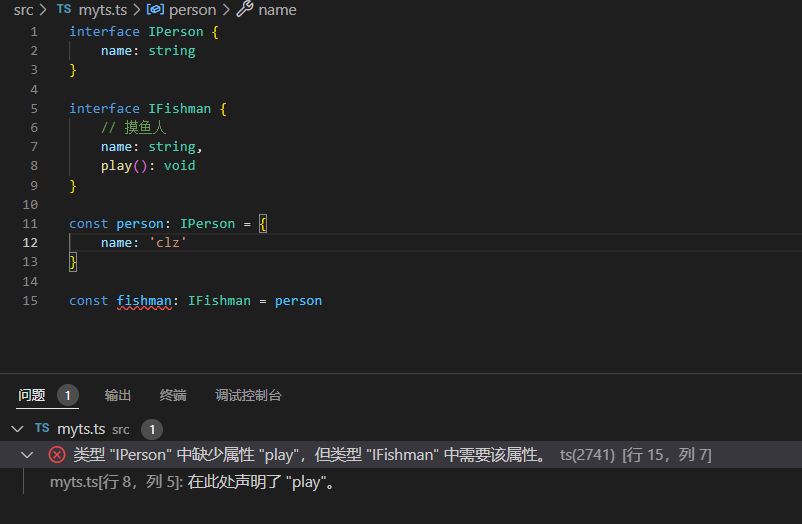攀爬TS之路(五) 类型断言
类型断言
第二段路时,已经提到联合类型:变量只能访问联合类型中所有类型共有的属性或方法
语法:值 as 类型 或 <类型>值
用途
将联合类型断言成其中的具体类型
1
2
3
4
5
6
7
8
9
10
11
12
13
14
15
16
17
18
19
| interface IFishman {
name: string,
play(): void
}
interface IWorker {
name: string
eat(): void
}
function myFunc(person: IFishman | IWorker) {
console.log(person.name)
person.play()
}
|
但是,有时候我们就是需要访问非公有的属性或方法。比如上面的例子中,当是Fishman时,调用play方法,当是Worker时,调用eat方法。
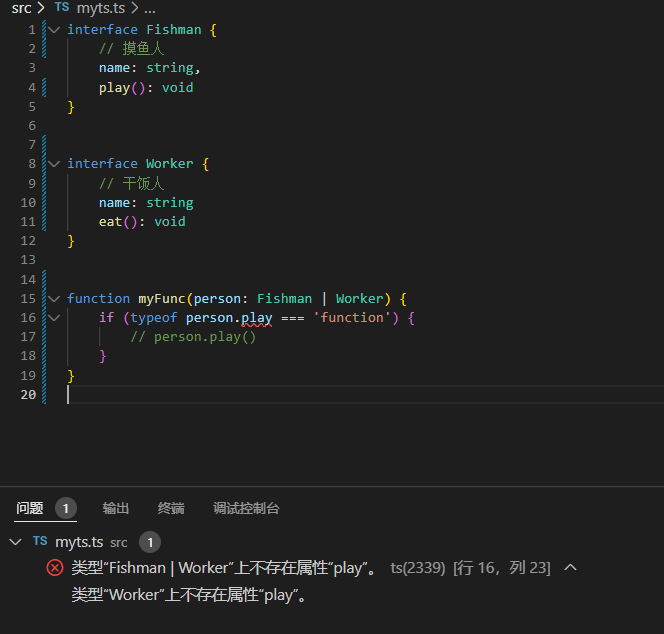
这时候,断言就能用来将联合类型断言成其中的具体类型。
1
2
3
4
5
6
7
8
9
10
11
12
13
14
15
16
17
18
19
20
21
22
23
24
25
26
27
| interface IFishman {
name: string,
play(): void
}
interface IWorker {
name: string,
eat(): void
}
function myFunc(person: IFishman | IWorker) {
(person as IFishman).play()
}
const fishman: IFishman = {
name: 'clz',
play: function () {
console.log('摸鱼')
}
}
myFunc(fishman)
|
乍一看,挺好的,但是,实际上只是隐藏其他情况而已,比如上面person as IFishman隐藏了person为IWorker的情况,这时候如果传入的参数是IWorker类型的,那就会报错,而且没法在编译阶段就暴露错误
1
2
3
4
5
6
7
8
| const worker: IWorker = {
name: 'clz',
eat: function () {
console.log('干饭')
}
}
myFunc(worker)
|
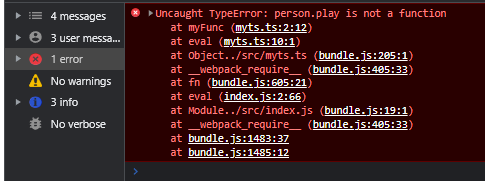
所以,使用断言时,应该非常注意,不然会增加一些运行时错误
将父类断言成更具体的子类
更准确来说,是将父类型断言成更具体的子类型,因为类的话,使用instanceof来判断就足够了。
但是,如果我们使用接口的话,它并不是类,而是类型,自然就不能使用instanceof来判断,这时候就需要使用断言来将父类型断言成更具体的子类型(实际上和将联合类型断言成其中的具体类型很像)
1
2
3
4
5
6
7
8
9
10
11
12
13
14
15
16
17
18
19
20
21
22
23
24
25
26
27
28
29
30
| class Person {
name: string
}
interface IFishman extends Person {
play(): void
}
interface IWorker extends Person {
eat(): void
}
function myFunc(person: Person) {
if (typeof (person as IFishman).play === 'function') {
return '摸鱼人'
} else if (typeof (person as IWorker).eat === 'function') {
return '干饭人'
}
}
const worker: IWorker = {
name: 'clz',
eat: function () { }
}
console.log(myFunc(worker))
|
将任何一个类型断言成any
我们使用JS进行开发时,有时候可以在window对象上添加新的属性,这个属性就能够全局访问了,但是,在TS中是会报错的,因为window对象没有该属性,就会报错。
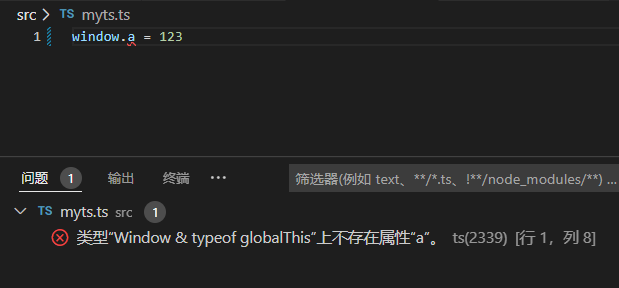
但是,这个做法实际上在开发中能够很便利,这个时候可以使用断言将它断言成any类型,这样子就能够添加新属性了。
需要注意的是,这样可能会掩盖真正的类型错误
将any断言成具体类型
设想一个情境,一个获取两个参数的和的函数,返回值按理应该是number类型,但是,结果却是any类型,这样子就会导致很多能在编译阶段暴露出的错误没法暴露出来。(这个情境是随便想的,简单来讲就是,历史代码不太好动,可能会引发蝴蝶效应)
1
2
3
4
5
6
| function mySum(a: number, b: number): any {
return a + b
}
const sum = mySum(9, 8)
console.log(sum.length)
|
比如上面,我们应该在访问sum.length时报错才对,但是因为是任意类型,所以不会报错,所以这时候就可能使用断言,将any断言成具体的类型,恢复它的在编译阶段报错的功能。
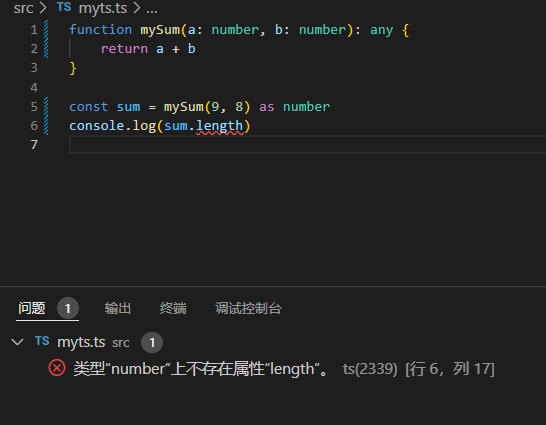
断言规则
如果A兼容B或者B兼容A,那么A能够被断言为B。
这里的兼容简单来说就是:A兼容B就是指类型A是类型B的子集。
1
2
3
4
5
6
7
8
9
10
11
12
13
14
15
16
| class Person {
name: string
}
interface IFishman extends Person {
play(): void
}
function testPerson(person: Person) {
return (person as IFishman)
}
function testIFishman(fishman: IFishman) {
return (fishman as Person)
}
|
上面的例子中,类型Person是类型IFishman的子集,即Person兼容IFishman,所以Person能被断言为IFishman,IFishman也能被断言为Person。
上面使用的Person是类,而IFishman是继承了Person,所以可能会误以为是继承关系导致的能否被断言。实际上,断言并不是根据是否有继承关系,而是看有没有兼容关系。所以下面的做法也是可以的。
1
2
3
4
5
6
7
8
9
10
11
12
13
14
15
16
17
| interface IPerson {
name: string
}
interface IFishman {
name: string,
play(): void
}
function testPerson(person: IPerson) {
return (person as IFishman)
}
function testIFishman(fishman: IFishman) {
return (fishman as IPerson)
}
|
如果类型A不兼容B,并且类型B不兼容A,那么A不能断言为B,B也不能断言为A。
比如number和string。
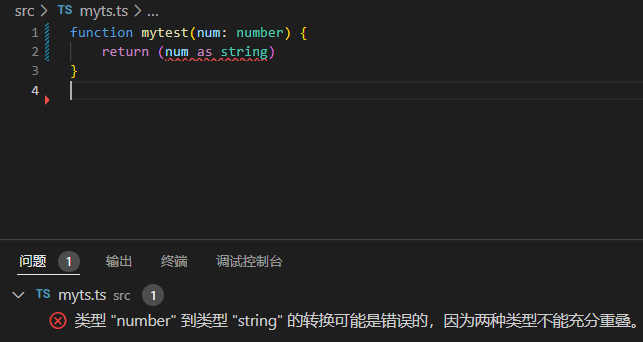
禁术:双重断言
- 任何类型都可以被断言成
any
any可以被断言成任何类型
所以,可以使用禁术双重断言把任何一个类型断言成任何另一个类型。
1
2
3
| function mytest(num: number) {
return (num as any as string)
}
|
除非迫不得已,千万别用双重断言。禁术:伤敌一千,自损八百
类型断言不会进行类型转换
类型断言只在TS编译时有效果,在编译结果中会被删除,不会影响到编译结果的类型。
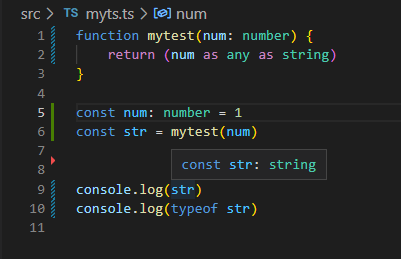
这个例子中,乍一看,断言还同时实现了类型的转换。
但是,都是假象。编译结果,立马打回原形。
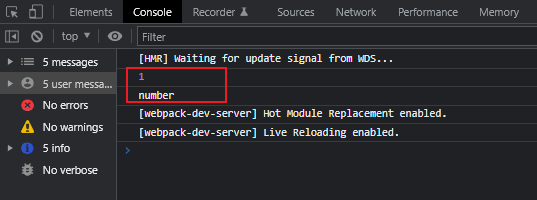
所以,需要进行类型转换还是得老老实实直接调用类型转换的方法。
1
2
3
4
5
6
7
8
9
10
| function mytest(num: number) {
return String(num)
}
const num: number = 1
const str = mytest(num)
console.log(str)
console.log(typeof str)
|
类型断言VS类型声明
1
2
3
4
5
6
| function mytest(num: number): any {
return num
}
const num = mytest(123) as number
console.log(typeof num)
|
我们可以使用断言将any类型断言为number类型。
当然我们也可以使用类型声明的方式来实现。
1
| const num: number = mytest(123)
|
这么一看,结果几乎是一样的。
实际上,类型声明的使用会比类型断言要更严格,所以使用类型断言很可能会导致一些隐藏问题。
先来看看,类型断言和类型声明的核心区别:
- A断言为B:需要满足A兼容B,或者B兼容A
- A赋值给B:只有满足B兼容A才行
1
2
3
4
5
6
7
8
9
10
11
12
13
14
15
| interface IPerson {
name: string
}
interface IFishman {
name: string,
play(): void
}
const person: IPerson = {
name: 'clz'
}
const fishman = person as IFishman
|
上面的断言:person兼容IFishman,所以IPerson类型能断言为IFishman类型,不过会有一些隐藏问题,比如IFishman
类型原本是需要有play方法的,但是用断言就直接出现了一个没有play方法的IFishman。
使用类型声明会更严格,但是也能够避免一些隐藏错误。
1
| const fishman: IFishman = person
|
